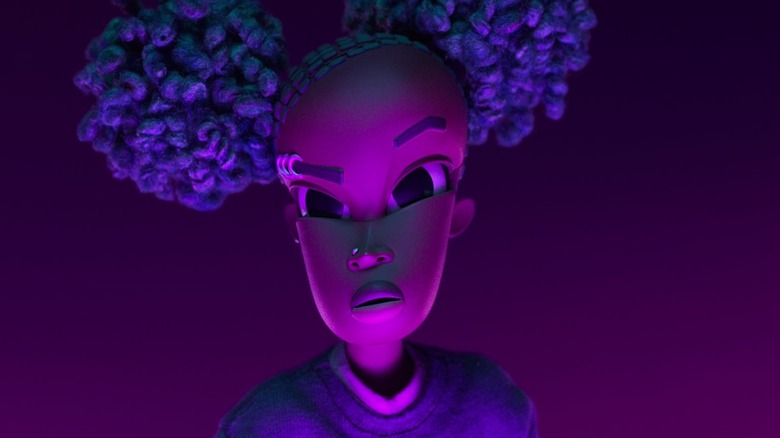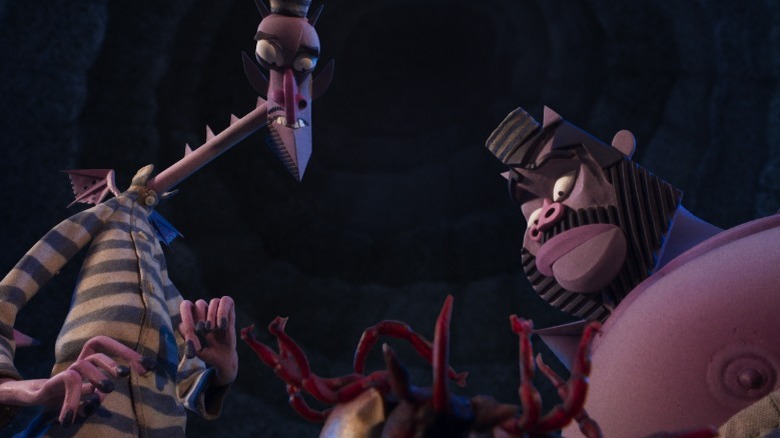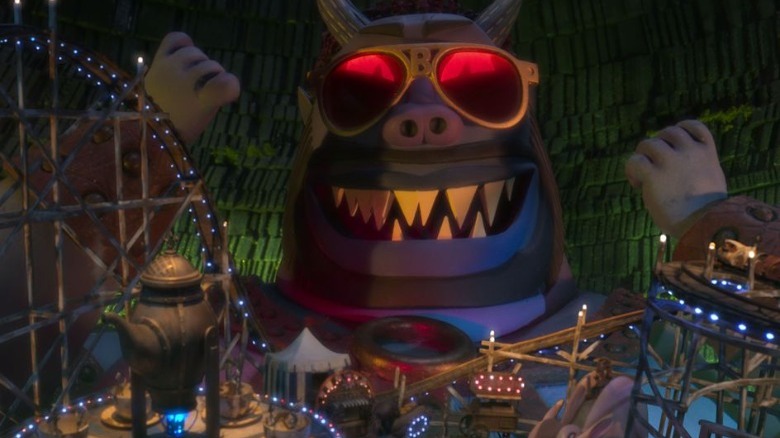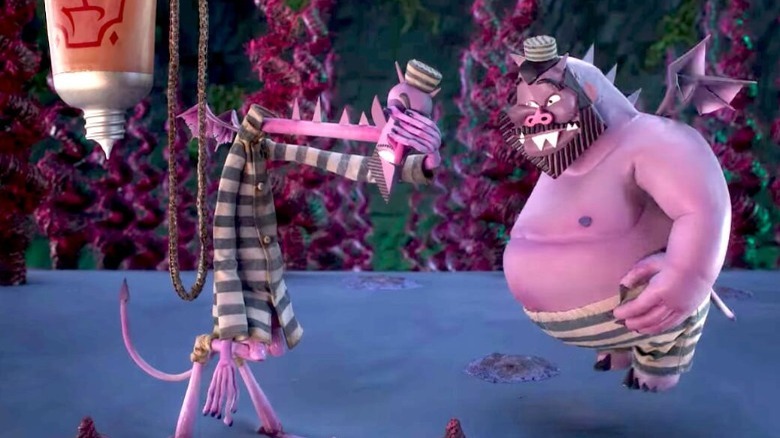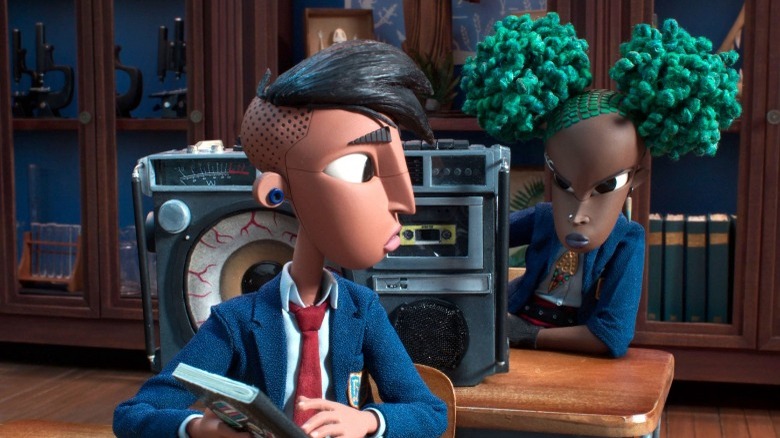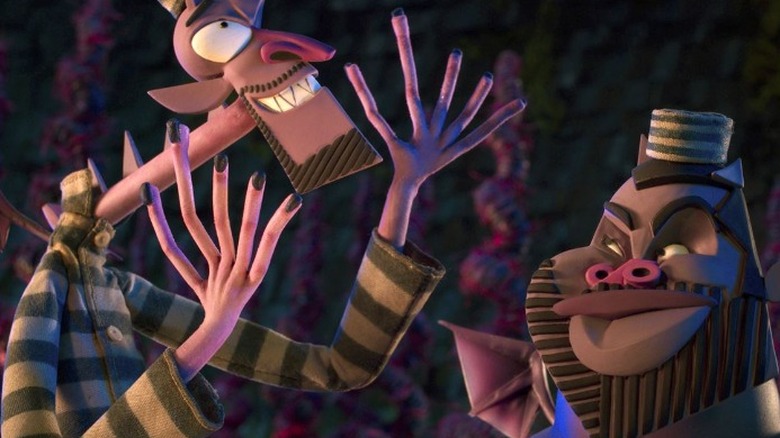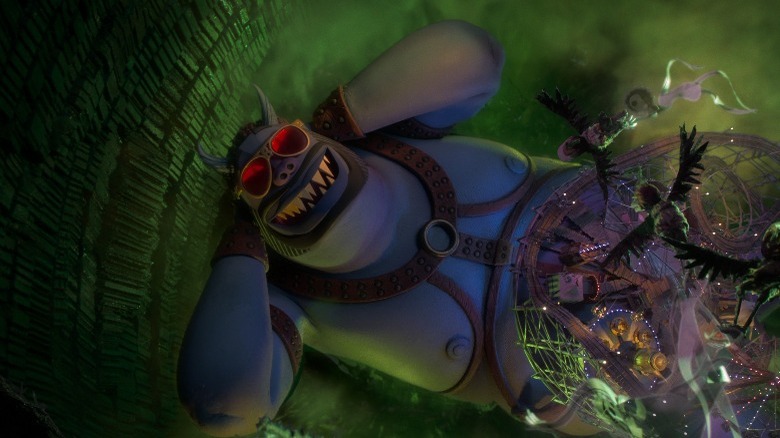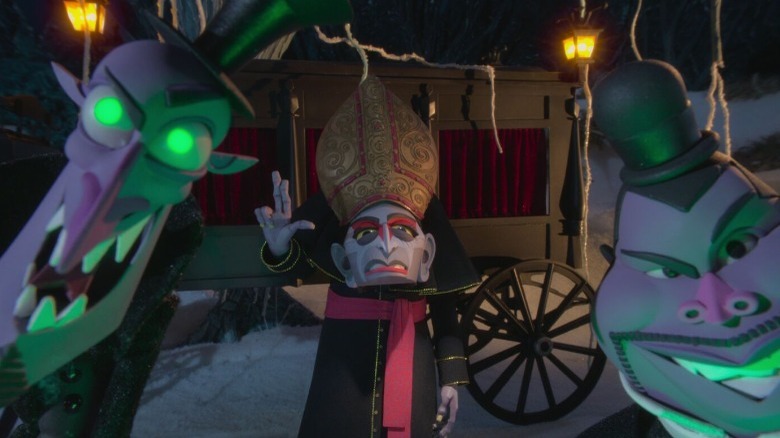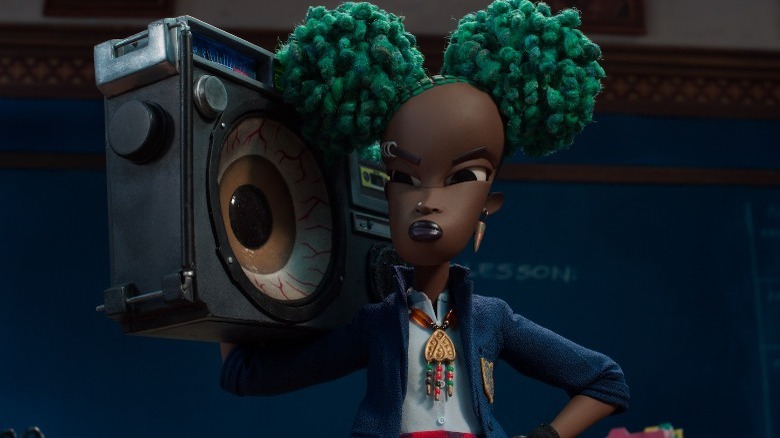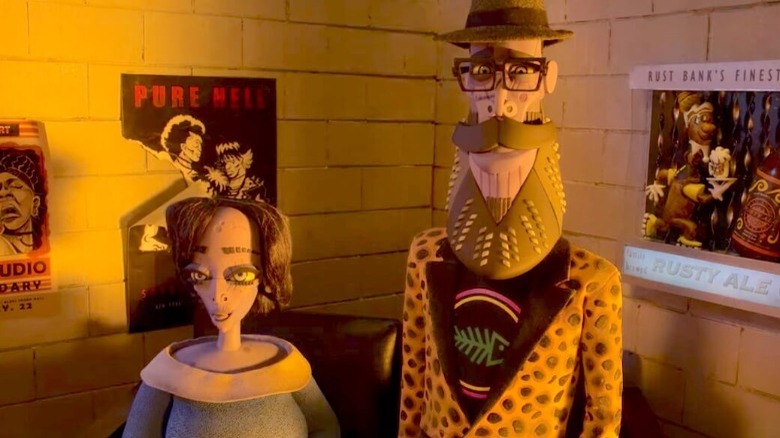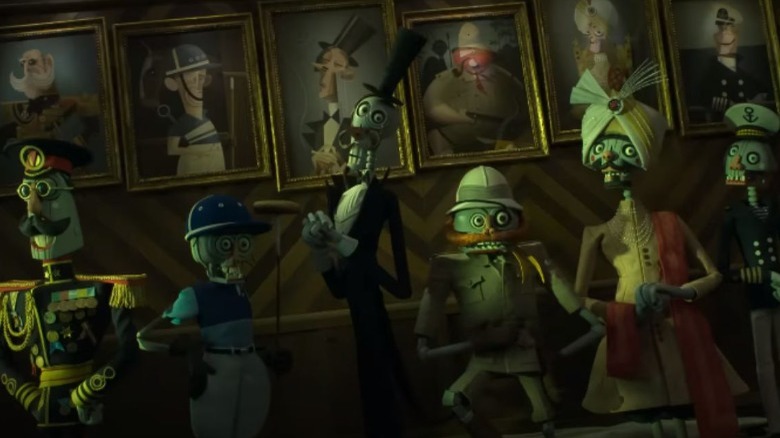Details Kids Won't Catch In Wendell & Wild
"Wendell & Wild," the latest animation offering from stop-motion juggernaut Henry Selick ("The Nightmare Before Christmas"), is as weird and wonderful as a Selick and Jordan Peele collaboration sounds. While only several weeks old, the film already feels buried beneath the sheer volume of television and movies Netflix released this Halloween season. As soon as one film lands on the streaming platform, hundreds of titles are waiting in the wings to take its place. But "Wendell & Wild" is not only Selick's first directorial outing since "Coraline," but also a stop-motion saga that deserves to stand alongside the latter as a pioneering piece of animation.
With a script co-written by Peele, "Wendell & Wild" is as funny — and scary — as his involvement suggests. The film revolves around Kat Elliot's (Lyric Ross) quest to revive her parents from the dead. "Wendell & Wild" barrels through a tapestry of gothic horror iconography, never letting its creative impulses cease. Sure, it's a kitchen sink approach, but it works. Despite its PG-13 rating, it's not as kid-friendly as other stop-motion films. Even within a more mature framework, Selick and Peele sneak in a few easter eggs for the adults. Here, we'll look at the 10 details kids likely missed in "Wendell & Wild."
Key & Peele in the titular roles
"Key & Peele" was one of this century's most successful sketch comedy outings. Even the uninitiated might know the classroom roll-call sketch or the valet movie fans. Considering the show ended in 2015, younger audiences are presumably unfamiliar with their sketch show. Having Keegan-Michael Key and Jordan Peele voice the demons Wendell and Wild, respectively, and the animators' decision to develop the characters' designs around their voice actors' appearances gives older viewers a fantastic easter egg.
Wendell and Wild look like miniature, demonic, stop-motion versions of their respective actors. But the gimmick never gets old. Of course, it helps that the actors share the same innate chemistry that made "Key & Peele" so successful. As a bonus, "Key & Peele" even featured a sketch with Peele portraying another Wendell — an obsessive pop culture fan. While there's perhaps no deeper connection, it's a fun wink nonetheless for the 30-something crowd.
The Scream Fair is Hell
Sure, adult viewers won't miss that the Scream Fair and Dream fair are the film's iterations of Hell and Heaven, respectively. But for younger audiences, the conceit's logical extension might be lost. If the Scream Fair is Hell, the departed souls trapped there must endure an eternity of horrific, terrifying rides with no end in sight. A twisted version of Dante's circles of Hell, it's gorgeously rendered in the movie with profound implications.
However, it's noteworthy — largely on account of how reticent children's movies are to explore death. Sure, Hades in "Hercules" is a mean dude. But it's never sufficiently explored just how terrifying his underworld is. Not here! From the introduction of "Wendell & Wild" onward, the Scream Fair feels like a fate worse than death. Selick expounded on this idea evolved during an interview with /Film's Rafael Motamayor, stating, "The main idea is that it goes back to my own experience where some crazy ride operator turns it up all the way and then doesn't hear the screams as he's torturing the people on the ride." (If that's not hellish, there's no telling what is!)
Getting high with hair cream
Although children's programs are reticent to discuss the implications of death and damnation, they're really, really keen on getting their characters high. "Avatar: The Last Airbender" did it with cactus juice, and everyone knows Scooby and Shaggy were high every episode with their "Scooby-Snacks" — a thinly-veiled euphemism for edibles. In "Wendell & Wild," the lead demons move along their father's head with hair cream, filling in plugs as they go. Wendell starts it off, remarking how the hair cream makes his tummy feel tickly when ingested. Soon, Wild is in on the fun, and their eyes spiral as they devolve into a trippy, totally chill trek along their father's scalp.
Obviously, the implication is that the hair cream is having a narcotic-like effect on the two — though this might go over younger audiences' heads. Yet it's hard not to imagine an awkward conversation between children and parents that settles on Wendell and Wild simply having a... "wild" time with safe hair cream. Nothing to see here!
Raúl is trans
"Wendell & Wild" does a lot right by Raúl Cocolotl (Sam Zelaya), Kat's only genuine friend at the start of the movie. While Kat doesn't initially see him that way, Raúl certainly does. As a result, he gets a few pretty remarkable character beats. Even better, little to no fuss is made about Raúl being trans. While never explicitly stated in the film, Zelaya confirmed that the character is trans (via Tudum). In "Wendell & Wild" characters apologize for deadnaming him, and his mother goes to bat with her boss on the phone, demanding he gets her son's pronouns correct.
What's most impressive is how "Wendell & Wild" never sermonizes. Raúl is who he is: It's never denigrated or used as the butt of the joke. Quietly and profoundly, Raúl exists in a piece of media principally targeted toward children. This kind of matter-of-fact representation matters considerably — especially given Pixar Animation Studio's censorship of queer representation on screen. Alongside a predominantly Black cast, it's remarkable to see "Wendell & Wild" pushing beyond the status quo, demanding trans representation for a younger audience.
Nigerian prince jokes
Every audience member who has lived through the beginning days of the internet knows what the "Nigerian Prince email scam" is. The setup goes something like this: a Nigerian Prince, one whose assets are currently frozen, needs you to wire him some money. If you do, you'll see your investment grow. Millions of dollars are promised for a small fee. Of course, this is a scam — but as of 2019, the Nigerian Prince scam brings in $700,000 annually.
While adults will crack a smile at "Wendell & Wild's" reference to Nigerian Princes, young audience members will wonder why their parents keeled over in laughter. As Wendell and Wild look to procure funds for their new fair, Wild remembers an old soul, a Nigerian Prince, who promised them a landfall of cash if they helped him to escape. Wendell quickly shuts the idea down, remarking it's a scam, and the joke ends. Still, it's funny enough — especially given the implication that those responsible for swindling thousands of dollars from unsuspecting individuals face damnation in the film's version of Hell.
Buffalo Belzer is Beelzebub
In "Wendell & Wild," the Scream Fair is overseen by none Buffalo Belzer (Ving Rhames), a not-so-thinly veiled euphemism for Beelzebub. While the roots of Beelzebub's origin differ in Philistine and Christian traditions, he often becomes conceptualized as Satan. Demonology sees him differently, positing him as the overseer of the gluttons and one of Hell's princes.
That interpretation fits with the afterlife we see in "Wendell & Wild." Souls aren't damned but "danged" — a softer, gentler interpretation of the greedy, lazy, and shady among us. Young audiences might miss the name play at work here. Instead, they might settle on Buffalo Belzer being another ooky, spooky character in something like the macabre but family-friendly world of "The Munsters" — not one with deep-seated demonological roots. Seeing Buffalo Belzer effectively being Satan renders some of the animated film's scariest elements much more fatalistic. With a PG-13 rating in tow, Selick is undoubtedly playing around with material the MPA has stifled or limited before.
The school to prison pipeline
While young audiences won't miss who's plaguing Kat, they probably won't fully understand the sheer, heartrending implications of Kat's conflict — one that supersedes even the living dead as the greatest threat plaguing Kat's life. After her parents die, Kat blames herself. To the film's credit, it's an excellent manifestation of survivor's guilt, as it shows Kat taking out her frustration on everyone around her. Rust Bank Catholic, the all girl's school where Kat attends, is her last stop. Otherwise, she's heading straight to prison. Given that the Klax Korp (a name that itself has an undercurrent of white supremacy, riffing on the KKK's name) is planning to develop a private prison in her town, this is no surprise to viewers.
In the real world, the school-to-prison pipeline disproportionally positions children from disadvantaged backgrounds to lose access to education and enter the prison system based on racist municipal policies and punishments. This potential reality for Kat becomes her biggest fear — one conceptualized during her exorcism in the film. Overall, it adds some much-needed mature gravitas to "Wendell & Wild." Kat isn't solely afraid of the undead. She's terrified of a system designed to make her fail.
Henry Selick's cracked faces
Selick used a stop-motion "splitting" technique animation to achieve the live-action-like design of the characters' facial expressions and movements (via Mashable). Animators split the stop-motion puppet into sections, granting them more control over the maneuverability of distinct body parts. This technique allows Kat's grief to manifest viscerally, why Raúl's pain is visible without him having to say a word — no differently than it would appear with real-life actors raising their eyebrows while they pout.
Speaking with IndieWire, Selick noted that the producers of "Coraline" had seams removed in post-production. Unlike Kat, Coraline's face doesn't have any evident cracks. With "Wendell & Wild," Selick opted to preserve the effect. While it's not a hugely noticeable visual cue, it helps "Wendell & Wild" stand out in the animation landscape. At a time when others question the integrity, eligibility, and credibility of animation, it's lovely to see Selick develop a unique style — preserving it in all its expressive, cracked glory.
Fishbone shirts
At different points in "Wendell & Willd," Kat and her father, Delroy (Gary Gatewood), wear Fishbone t-shirts. While young audiences might miss the reference — presuming them to be their outfits — astute adult viewers will note it as an homage to Selick's earliest work. In 1985, Selick directed a Fishbone music video for "Party at Ground Zero." Fishbone is an all-Black American rock band that formed in 1979 and distinctly melded conventional rock with reggae, punk, and ska. Additionally, the Afropunk soundtrack for "Wendell & Wild" harkens back to this too.
The iconography is a touching tribute that has profound narrative implications too. Kat carries her father's stereo around with her through most of the film as her prized possession: It's the one channel where she can still feel her father with her. In other words, music plays a healing and empowering role amidst Kat's bereavement. Selick pays homage to not only his history but the curative nature of Black punk music writ large.
Buying votes
While viewers are probably sick of hearing bogus claims of voter fraud in their real lives, "Wendell & Wild" taps into some perennial societal problems with its plot beat concerning the Klax Korp's desire. As a group, they want to raise the dead, ensuring enough council votes to approve the construction of their private prison. Young audiences will catch onto enough — having zombies vote is wrong — but the full breadth of what it means might elude them.
Minority voters in America often have their voices and votes suppressed. As "Wendell & Wild" contends, their voices alone aren't presently enough in a system innately pitted against them. Senior Director of Voting Rights at the Leadership Conference on Civil and Human Rights Leslie Proll said in October 2022 that the "criminalization of the vote" is worse now than it was in the Jim Crow era (via The Guardian). In the moments when the film delves into voting access and qualifications to achieve a financial goal only beneficial to some, "Wendell & Wild" gives viewers an existential and all too real nightmare.
